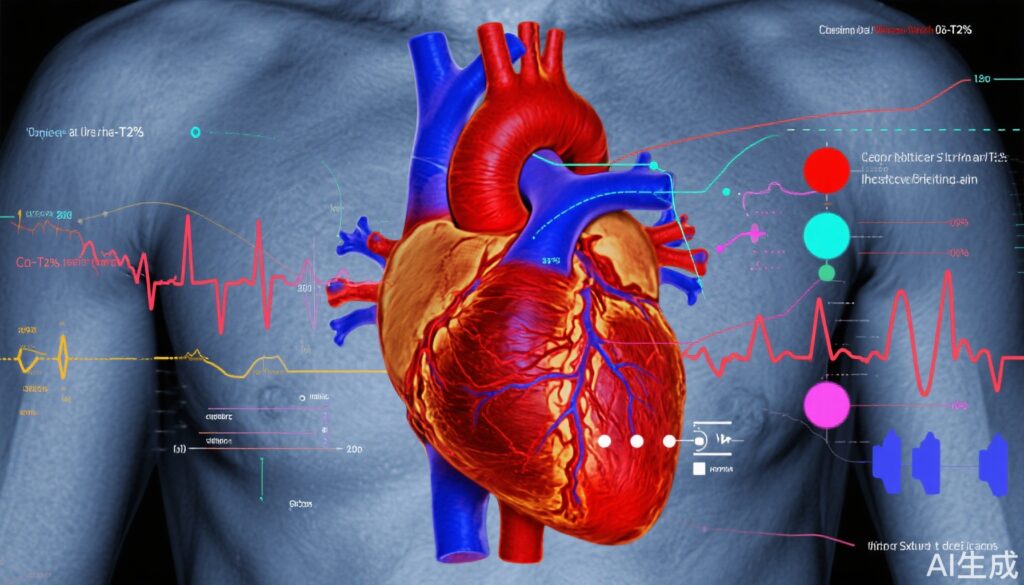Study Background and Disease Burden
Heart failure with reduced ejection fraction (HFrEF) is a major public health burden worldwide, associated with high morbidity, mortality, and impaired quality of life. Anaemia commonly coexists in this population and is linked to worse clinical outcomes. Iron metabolism dysregulation, including disturbances in myocardial iron content (MIC), has been implicated in heart failure pathophysiology, affecting myocardial function and systemic oxygen delivery. Sodium-glucose cotransporter 2 inhibitors (SGLT2i), originally used for glycemic control, have demonstrated cardiovascular benefits in heart failure, but their effects on iron homeostasis and the underlying mechanisms remain incompletely understood.
Study Design
The EMPATROPISM-FE trial was a randomized, placebo-controlled study designed to evaluate the effects of empagliflozin, an SGLT2 inhibitor, on myocardial structure and function in patients with HFrEF. This post hoc analysis included 80 participants, stratified by anaemia status (haemoglobin < 13 mg/dL in men, < 12 mg/dL in women). Key assessments at baseline and after 6 months of treatment included myocardial iron content estimated by cardiac magnetic resonance T2* imaging, left ventricular (LV) volumes, LV ejection fraction (LVEF), peak oxygen consumption (VO2max), laboratory iron markers (LIM), haemoglobin, haematocrit, erythropoietin, and plasma norepinephrine as a marker of sympathetic activity.
Key Findings
At baseline, 30% of patients presented with anaemia. Compared to non-anaemic patients, those with anaemia exhibited significantly higher cardiac T2* values, indicating lower MIC (P < 0.001), reduced exercise capacity (lower VO2max, P = 0.024), decreased hepcidin levels (P = 0.017), and elevated erythropoietin (P = 0.040) and norepinephrine (P = 0.016) levels.
Across all participants, lower MIC correlated significantly with larger LV volumes (P < 0.01), increased norepinephrine concentrations (P < 0.001), and reduced LVEF (P < 0.01), VO2max (P < 0.001), and haemoglobin/haematocrit (P 0.10), suggesting the superiority of imaging-based assessment of myocardial iron status over conventional blood tests.
Treatment with empagliflozin for 6 months significantly increased MIC (P < 0.012), enhanced exercise capacity, and stimulated haematopoiesis. However, changes in LIM and norepinephrine suggested ongoing systemic iron depletion alongside sympatholysis. Importantly, left ventricular reverse remodelling was more pronounced in patients with anaemia, indicating a greater structural benefit in this subgroup.
Expert Commentary
The EMPATROPISM-FE trial uncovers a critical interplay between anaemia, myocardial iron availability, and sympathetic nervous system activity in heart failure. These findings support the concept that impaired cellular iron uptake or availability contributes to myocardial dysfunction, decreased exercise tolerance, and compromised haematopoiesis in HFrEF. The observed increase in myocardial iron content with empagliflozin treatment suggests a novel cardioprotective mechanism potentially mediated by attenuation of sympathetic overactivity (sympatholysis). This sympatholytic effect may underlie multiple systemic and cardiac benefits of SGLT2 inhibitors, aligning with emerging data highlighting neurohormonal modulation in heart failure therapy.
Limitations include the post hoc nature of the analysis and the relatively modest sample size, which warrant cautious interpretation and call for larger prospective studies. Additionally, the incongruence between myocardial iron imaging and traditional laboratory iron markers indicates a need for refinement of iron status evaluation in this context.
Conclusions
Anaemia predicts dysregulation of iron homeostasis and modulates the therapeutic response to empagliflozin in patients with HFrEF. Empagliflozin increases myocardial iron content and decreases sympathetic activity, leading to improved cardiac structure, function, exercise capacity, and haematopoietic activation. These data highlight dysregulated iron metabolism as a shared, treatable pathway in heart failure and suggest that sympatholysis contributes to the diverse clinical benefits of SGLT2 inhibitors. This new understanding may guide more personalized treatment approaches and inform future research targeting iron metabolism and neurohormonal modulation in heart failure.
References
Angermann CE, Sehner S, Gerhardt LMS, Santos-Gallego CG, Requena-Ibanez JA, Zeller T, Maack C, Sanz J, Frantz S, Ertl G, Badimon JJ. Anaemia predicts iron homoeostasis dysregulation and modulates the response to empagliflozin in heart failure with reduced ejection fraction: the EMPATROPISM-FE trial. Eur Heart J. 2025 Apr 22;46(16):1507-1523. doi: 10.1093/eurheartj/ehae917. PMID: 39907687; PMCID: PMC12011522.


